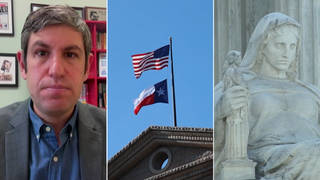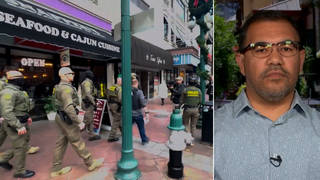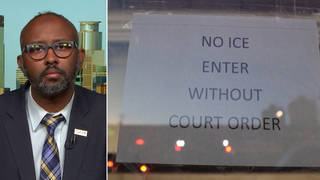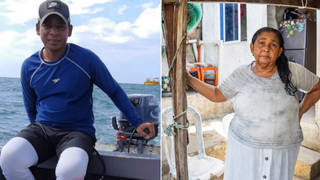
As Israel continues bombarding the Gaza Strip, we speak with a Palestinian photographer who recently fled the territory with his family. Ahmed Zakot has been documenting Gaza for the last 25 years, and two of his photographs were just featured in a project by the U.N. Office for the Coordination of Humanitarian Affairs and published by Rolling Stone earlier this month in a piece titled “Gaza’s Carnage Through the Eyes of Palestinian Photojournalists.” One of Zakot’s photos shows a Gaza neighborhood lit up by Israeli airstrikes at night, while the second is of thousands of Palestinians fleeing their homes with their belongings in a scene reminiscent of the 1948 Nakba that displaced some 700,000 Palestinians from their homes. “It reminds me [of] what my grandfather told me about this displacement. It’s the same [that] happened since 1948 — now we are in 2024,” Zakot says.
Transcript
AMY GOODMAN: This is Democracy Now!, democracynow.org, The War and Peace Report. I’m Amy Goodman.
Israeli warplanes bombed areas in Beit Lahia in the northern Gaza Strip as well as the Jabaliya refugee camp in Gaza City over the last day, killing at least four people. Meanwhile, Al Jazeera reports the Israeli military has deployed more troops in areas adjacent to Rafah, the southernmost city of Gaza, where some 1.3 million Palestinians — more than half of Gaza’s population — are seeking shelter. Israeli airstrikes have been pounding agricultural land in the eastern parts of Rafah this morning.
The official death toll in Gaza is nearly 34,000 Palestinians killed, over 14,000 of them children. Thousands more are missing and presumed dead under the rubble. Nearly 77,000 have been wounded. That’s 100,000 Palestinians killed or wounded since October 7th.
This comes as a picture by the Gaza-based Reuters photojournalist Mohammed Salem has been chosen as the 2024 World Press Photo of the Year. It shows a Palestinian woman, Inas Abu Maamar, caressing the wrapped body of her dead niece Saly in the Nasser Hospital morgue in Khan Younis in October.
Well, today we’re joined by a Palestinian photographer who was able to leave Gaza 10 days ago with his family. Ahmed Zakot [@ahmedzakot] is a photographer who’s documented Gaza for the past 25 years. Two of his photographs are featured in a U.N. OCHA project. Ahmed Zakot joins us now from Cairo, Egypt.
Ahmed, welcome to Democracy Now! You’ve just recently left Gaza. Can you talk about the journey you took and why, as a photographer who’s documented Gaza for the last quarter of a century, you decided to leave with your family?
AHMED ZAKOT: Thank you so much, and I’m very happy to join you today.
Actually, what forced us to leave Gaza is to be safe and to keep our family lives safe. As you know, it’s a war ongoing since seven months. And it’s a very, very hard war. I’m working since 25 years. This is the first war that I faced. It’s a very, very strong war. And we don’t know how we are be patient to keep to stay alive during this seven months. Actually, this war is keeping and still ongoing on Gaza Strip. So, each month, we talk to us that this war will stop and the international community will stop this war, but, actually, no one — nothing changed, and the war is still ongoing until this moment.
AMY GOODMAN: Ahmed, you left, but you have two brothers, their wives and children. Where are they in Gaza right now? What circumstances are they living in?
AHMED ZAKOT: Yeah, of course. I left two brothers, wives and their children in Khan Younis at al-Mawasi area, that the Israeli army said it is a humanitarian area. But, actually, nowhere, no place in Gaza Strip are safe, because I was there, and we are — all of us, we lived in tents on this area. This area, it’s like desert — no water, no food, no useful food. And it’s a danger areas, because the Israeli army, by time to time, targeted tents and targeted many targets over there. So, we are seeking and we are trying to evacuate them from Gaza Strip as soon as possible to follow us here in Egypt to be safe, because, as I said, this war are still ongoing. The situation of my family and all the Palestinians’ situation are very, very catastrophic and very, very bad over there. No one can live, and no one can guarantee that he will wake up the next morning, he is alive, or he is not wounded.
AMY GOODMAN: Ahmed Zakot, so many of your photographs feature children, also ambulances. Can you talk about your focus right now as you photographed in Gaza these last six months?
AHMED ZAKOT: Yes, of course. Our coverage this war is different about many last wars in Gaza. As you know, Gaza Strip occurred four wars, at least. And I covered them, but this war was special, and because of — it’s special about me as a photojournalist for 25 years because the intensive hits, the intensive heavy attacks on the neighborhoods, the cities, the buildings, and also it hits the civilians, the innocent people, actually. So it’s different. This is the first time I felt the fear and terror of this war on me and on my brothers, my family, completely, actually.
So, I can’t explain this war, because it’s a very, very big war. We can say each area that we went and cover it, we can say it’s like an earthquake hit this area, not bombard and bombs hit this area. There are a lot of destruction buildings in each single piece and place in Gaza Strip. So, we are focusing on children, women and on the ambulances’ teams and all of the civilians that were hit on this war.
AMY GOODMAN: Ahmed Zakot, two of your photographs are featured in an OCHA project. That’s the U.N. Office for Coordination of Humanitarian Affairs. It’s a project called —
AHMED ZAKOT: Yes, of course. I’m —
AMY GOODMAN: — “Gaza’s Carnage Through the Eyes of Palestinian Photojournalists.” One of them was taken on October 9th, the other on November 10th. Can you describe these photographs that you chose for this project? In your description of the photograph from October 9th, it says, “It was as if flames were spewing from the jaws of Israeli tanks and the F-16 missiles, I took this picture from the 19th floor of a skyscraper in Gaza. In my 25-year career as a photographer, I never felt such fear and distress.”
AHMED ZAKOT: Yes, of course. This picture — yes —
AMY GOODMAN: “I felt that I was filming a cinematic movie scene, I had to remind myself that it is all too real. I don’t have the words to describe this picture, but I know the terror I felt watching the flames lighting up Gaza in a night drowned in darkness with the electricity cut-offs on Gaza.” We’re, Ahmed, looking at your picture as you talk to us about it, that picture you took in October.
AHMED ZAKOT: Yes, of course. This is the first time that I captured such this picture, because, as I said and as I explained, I thought myself that I’m shooting or capturing a cinematic scene, because this is the first time I saw a heavy of air attacks on a simple area. It was al-Rimal neighborhood. It is the beautiful neighborhood in Gaza. And this night, it was because of the heavy and the intensive attacks from the airstrikes, they are lighting the area amid of this darkness. As you know, Gaza are suffering from power cut for many years, since 2006. But this time I felt that Gaza is lighting, but not with electricity, by the lights comes from the bombs and airstrikes from the F-16 warplanes. So, this picture are still stuck on my mind until now, and will stick in my mind forever, because I felt that really I’m in a cinematic scene, not in a real war that’s hitting the areas and the buildings over there.
AMY GOODMAN: And I wanted to end —
AHMED ZAKOT: This is why this picture are still stuck and has a story with me.
AMY GOODMAN: Ahmed, I wanted to end with your other photograph, from November. It is a photograph of thousands of displaced Palestinians fleeing south. You wrote, “As I was taking this picture; I remembered my grandfather telling me about al-Nakba and how he was displaced. I started crying.”
AHMED ZAKOT: Yes.
AMY GOODMAN: Tell us about —
AHMED ZAKOT: Of course, I remember this picture. So, I was crying. I stopped my capturing pictures at that day especially, because I remembered my grandfather’s story that he told me before he passed away in 2002. He told me about al-Nakba stages, when the Israeli forces forced them to leave the original cities in Israel to the southern cities in Gaza Strip. So, he told me one word, that this scene will not get back at this time. So, when I captured this scene, I remembered this word from him that when he told me this sentence, that when he told me before he passed away, that this scene will not get back.
But now we are shooting this picture. We are shooting this situation, this displacement for this people, for those people who are suffering. As you see in the picture, they are carrying their belongings at their help and weak hands. So, they are fleeing from the northern cities of Gaza Strip to the southern cities. So, it reminds me what my grandfather told me about this displacement. It’s the same happened since 1948 — now we are in 2024, or 2023, by the way. So, this reminded me and stuck my heart. I stopped my work and keep crying, away from my friends that we are together at that day.
AMY GOODMAN: Ahmed, can you talk about how you got out of Gaza with your family? Can you talk about — what? An adult has to pay something like $7,000, $8,000. It’s $2,500 for a child. Explain the circumstances, how you get out, as the Israeli military says it is intent on now attacking Rafah, where people leave from.
AHMED ZAKOT: So, yes, we are leave Gaza — we are left Gaza by I coordinating with the Egyptian Press Syndicate, and they arranging that to me and to my family because I’m a journalist. So they helped me to do that. Really, really, I appreciated that for them and very thankful for them, because they helped me to leave Gaza here to Egypt to at least stay for maybe one or two months, until the war will stop. So, I will get back to my city, to Gaza, to the Gaza Strip, to keep working and to keep sending messages and to keep covering the suffers of my people in Gaza Strip.
AMY GOODMAN: Ahmed Zakot, I want to thank you so much for being with us, Palestinian photographer, forced to leave Gaza with his family 10 days ago.
Coming up, we will look —
AHMED ZAKOT: Thank you so much.
AMY GOODMAN: — at the U.N. project, the Gaza Collective Photo Essay project, and the work of more Palestinian photojournalists. Stay with us.











Media Options